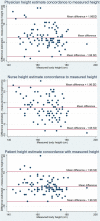Impact of Height Estimation on Tidal Volume Calculation for Protective Ventilation-A Prospective Observational Study
- PMID: 34079949
- PMCID: PMC8162955
- DOI: 10.1097/CCE.0000000000000422
Impact of Height Estimation on Tidal Volume Calculation for Protective Ventilation-A Prospective Observational Study
Abstract
Objectives: The current standard of care to deliver invasive mechanical ventilation support is the protective ventilation approach. One pillar of this approach is the limitation of tidal volume to less than 6 mL/Kg of predicted body weight. Predicted body weight is calculated from patient's height. Yet, little is known about the potential impact of errors arising from visual height estimation, a common practice, to calculate tidal volumes. The aim of this study was to evaluate that impact on tidal volume calculation to use during protective ventilation.
Design: Prospective observational study.
Setting: An eight-bed polyvalent ICU.
Patients: Adult patients (≥ 18 yr).
Interventions: None.
Measurements and main results: Tidal volumes were calculated from visual height estimates made by physicians, nurses, and patients themselves and compared with tidal volumes calculated from measured heights. Comparisons were made using the paired t test. Modified Bland-Altman plots were used to assess agreement between height estimates and measurements. One-hundred patients were recruited. Regardless of the height estimator, all the mean tidal volumes would be greater than 6 mL/Kg predicted body weight (all p < 0.001). Additionally, tidal volumes would be greater than or equal to 6.5 mL/Kg predicted body weight in 18% of patients' estimates, 25% of physicians' estimates, and 30% of nurses' estimates. Patients with lower stature (< 165 cm), older age, and surgical typology of admission were at increased risk of being ventilated with tidal volumes above protective threshold.
Conclusions: The clinical benefit of the protective ventilation strategy can be offset by using visual height estimates to calculate tidal volumes. Additionally, this approach can be harmful and potentially increase mortality by exposing patients to tidal volumes greater than or equal to 6.5 mL/Kg predicted body weight. In the interest of patient safety, every ICU patient should have his or her height accurately measured.
Keywords: acute respiratory distress syndrome; body height; critical care; intensive care units; pulmonary ventilation; quality improvement.
Copyright © 2021 The Authors. Published by Wolters Kluwer Health, Inc. on behalf of the Society of Critical Care Medicine.
Conflict of interest statement
The authors have disclosed that they do not have any potential conflicts of interest.
Figures
Similar articles
-
Size matters: An observational study investigating estimated height as a reference size for calculating tidal volumes if low tidal volume ventilation is required.PLoS One. 2018 Jun 29;13(6):e0199917. doi: 10.1371/journal.pone.0199917. eCollection 2018. PLoS One. 2018. PMID: 29958278 Free PMC article. Clinical Trial.
-
Association Between Tidal Volumes Adjusted for Ideal Body Weight and Outcomes in Pediatric Acute Respiratory Distress Syndrome.Pediatr Crit Care Med. 2019 Mar;20(3):e145-e153. doi: 10.1097/PCC.0000000000001846. Pediatr Crit Care Med. 2019. PMID: 30640889 Free PMC article.
-
Variability in Pediatric Ideal Body Weight Calculation: Implications for Lung-Protective Mechanical Ventilation Strategies in Pediatric Acute Respiratory Distress Syndrome.Pediatr Crit Care Med. 2018 Dec;19(12):e643-e652. doi: 10.1097/PCC.0000000000001740. Pediatr Crit Care Med. 2018. PMID: 30277896 Free PMC article.
-
Comparison of usual and alternative methods to measure height in mechanically ventilated patients: potential impact on protective ventilation.Respir Care. 2014 Jul;59(7):1025-33. doi: 10.4187/respcare.02732. Epub 2013 Nov 19. Respir Care. 2014. PMID: 24255160 Clinical Trial.
-
Trend Analysis: Evolution of Tidal Volume Over Time for Patients Receiving Invasive Mechanical Ventilation.2016 Sep 10. In: MIT Critical Data, editor. Secondary Analysis of Electronic Health Records [Internet]. Cham (CH): Springer; 2016. Chapter 18. 2016 Sep 10. In: MIT Critical Data, editor. Secondary Analysis of Electronic Health Records [Internet]. Cham (CH): Springer; 2016. Chapter 18. PMID: 31314271 Free Books & Documents. Review.
References
-
- Brower RG, Matthay MA, Morris A, et al. ; Acute Respiratory Distress Syndrome Network: Ventilation with lower tidal volumes as compared with traditional tidal volumes for acute lung injury and the acute respiratory distress syndrome. N Engl J Med. 2000; 342:1301–1308 - PubMed
-
- Devine B. Gentamicin therapy. Drug Intell Clin Pharm. 1974; 8:650–655
-
- Bloomfield R, Steel E, MacLennan G, et al. . Accuracy of weight and height estimation in an intensive care unit: Implications for clinical practice and research. Crit Care Med. 2006; 34:2153–2157 - PubMed
-
- Leary TS, Milner QJ, Niblett DJ. The accuracy of the estimation of body weight and height in the intensive care unit. Eur J Anaesthesiol. 2000; 17:698–703 - PubMed
LinkOut - more resources
Full Text Sources
Other Literature Sources



